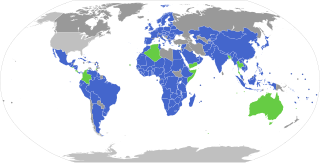|
Nagoya Protocol
The Nagoya Protocol on Access to Genetic Resources and the Fair and Equitable Sharing of Benefits Arising from their Utilization to the Convention on Biological Diversity, also known as the Nagoya Protocol on Access and Benefit Sharing (ABS), is a 2010 supplementary agreement to the 1992 Convention on Biological Diversity (CBD). Its aim is the implementation of one of the three objectives of the CBD: the fair and equitable sharing of benefits arising out of the utilization of genetic resources, thereby contributing to the conservation and sustainable use of biodiversity. It sets out obligations for its contracting parties to take measures in relation to access to genetic resources, benefit-sharing and compliance. The protocol was adopted on 29 October 2010 in Nagoya, Japan, and entered into force on 12 October 2014. As of April 2022[update], it has been ratified by 137 parties, which includes 136 UN member states and the European Union. Concerns have been expressed that the added bureaucracy and legislation could be damaging to the monitoring and collection of biodiversity, to conservation, to the international response to infectious diseases, and to research.[1][2] Aims and scopeThe Nagoya Protocol applies to genetic resources that are covered by the CBD, and to the benefits arising from their utilization. The protocol also covers traditional knowledge associated with genetic resources that are covered by the CBD and the benefits arising from its utilization. Its aim is the implementation of one of the three objectives of the CBD: the fair and equitable sharing of benefits arising out of the utilization of genetic resources, thereby contributing to the conservation and sustainable use of biodiversity.[3] Adoption and ratificationThe protocol was adopted on 29 October 2010 in Nagoya, Japan, at the tenth meeting of the Conference of the Parties, held from 18 to 29 October 2010[4] and entered into force on 12 October 2014. As of April 2022[update], it has been ratified by 137 parties, which includes 136 UN member states and the European Union.[5] ObligationsThe Nagoya Protocol sets out obligations for its contracting parties to take measures in relation to access to genetic resources, benefit-sharing and compliance.[citation needed] Access obligationsDomestic-level access measures aim to:[citation needed]
Benefit-sharing obligationsDomestic-level benefit-sharing measures aim to provide for the fair and equitable sharing of benefits arising from the utilization of genetic resources with the contracting party providing genetic resources. Utilization includes research and development on the genetic or biochemical composition of genetic resources, as well as subsequent applications and commercialization. Sharing is subject to mutually agreed terms. Benefits may be monetary or non-monetary such as royalties and the sharing of research results.[citation needed] Compliance obligationsSpecific obligations to support compliance with the domestic legislation or regulatory requirements of the contracting party providing genetic resources, and contractual obligations reflected in mutually agreed terms, are a significant innovation of the Nagoya Protocol.[citation needed] Contracting parties are to:[citation needed]
Implementation The Nagoya Protocol's success will require effective implementation at the domestic level. A range of tools and mechanisms provided by the Nagoya Protocol will assist contracting parties including:[citation needed]
Based on a country's self-assessment of national needs and priorities, capacity-building may help to:[citation needed]
Relationship to other international agreementsA growing number of Preferential Trade Agreements (PTAs) include provisions related to access to genetic resources or to the sharing of the benefits that arise out of their utilization. Indeed, some recent trade agreements, originating notably from Latin American countries, provide specific measures designed to facilitate the implementation of the ABS provisions contained in the Nagoya Protocol, including measures related to technical assistance, transparency and dispute settlement.[6] CriticismHowever, there are concerns that the added bureaucracy and legislation will, overall, be damaging to the monitoring and collection of biodiversity, to conservation, to the international response to infectious diseases, and to research.[7][2][8] Many scientists have voiced concern over the protocol, fearing the increased red tape will hamper disease prevention and conservation efforts,[1] and that the threat of possible imprisonment of scientists will have a chilling effect on research.[7][8] Non-commercial biodiversity researchers and institutions such as natural history museums fear maintaining biological reference collections and exchanging material between institutions will become difficult.[2] Lack of implementation at the national level was frequently attributed as a major factor behind the failure of Nagoya Protocol.[9] See also
References
Further reading
External links
|
||||||||||||||||||||||
